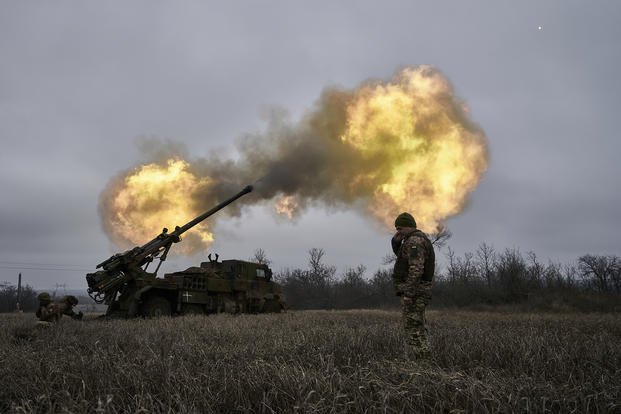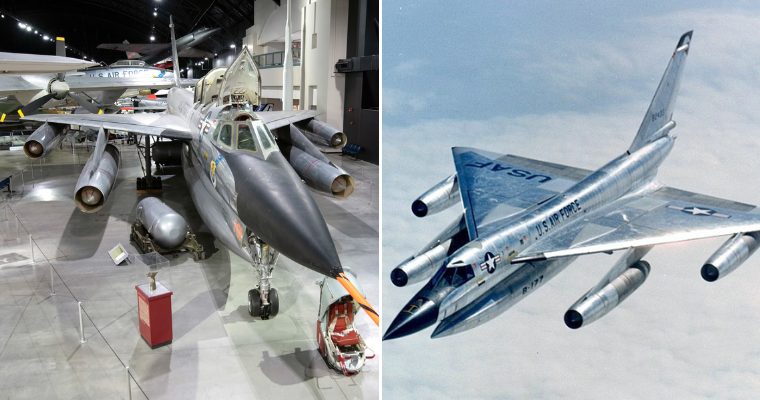
Ukrainian soldiers fire a French-made CAESAR self-propelled howitzer toward Russian positions near Avdiivka, Donetsk region, Ukraine, Monday, Dec. 26, 2022. (Libkos/AP Photo)
Gary Anderson lectures on wargaming and red teaming at the George Washington University’s Elliott School of International Affairs.
The opinions expressed in this op-ed are those of the author and do not necessarily reflect the views of Military.com. If you would like to submit your own commentary, please send your article to opinions@military.com for consideration.
Russian President Vladimir Putin has threatened to use hypersonic missiles against Ukraine. The Ukrainians are unimpressed, and we should not be surprised.
They have taken their measure of Russia and its military and found them wanting. Throughout recent history, nations in the process of losing wars have resorted to “wonder weapons” as a last-ditch effort to stave off disaster.
During World War I, Germany hoped that the use of poison gas would break the stalemate on the Western Front, but it only made an unpleasant situation more miserable. Adolf Hitler pinned his hopes on the V-1 and V-2 rockets, and jet aircraft. Defense Secretary Robert McNamara hoped that sensors and defoliants would defeat North Vietnamese infiltration into South Vietnam. The end result has been thousands of veterans suffering from Agent Orange-related diseases.
The use of technology to break the will of a determined opponent usually fails, although sometimes it gives one side or the other a temporary advantage. It took the French almost a century to figure out how to counter the English longbow, but the Confederate use of ironclad technology was countered near-immediately by the Union’s USS Monitor during our Civil War.
Ukraine has had 10 months to evaluate the capabilities and limitations of Russian weapons. Worse still for Putin, thanks to poor generalship and morale, many of those weapons are now in Ukrainian hands.
Hypersonic weapons would likely give the Russians a distinct advantage if their war with Ukraine was being fought on the Black Sea or if Ukraine was trying to use what little navy it has. But so far, it has been the Ukrainians who have effectively used relatively mid-tech, anti-ship missiles in a land-based role.
The Ukrainians are not impressed with the Russian hypersonic threat for two reasons. First, they realize that their distributed and decentralized method of fighting gives the Russians very few targets against which hypersonic weapons could pose a decisive threat.
If Moscow’s amazingly inept intelligence targeting approach could ever pinpoint the exact location of Ukraine President Volodymyr Zelenskyy, a hypersonic missile might take him out. Then what? Zelenskyy would become a martyr, and that would likely harden Ukrainian resolve.
The second reason follows the first. Russia does not have many of these weapons, and they are very expensive. The cost-benefit ratio would work against Moscow. The same logic works against the Russians when they contemplate the use of tactical nuclear weapons. The analogy of using a sledgehammer to swat a gnat in the proverbial China shop is apt here.
Putin’s problem is very similar to what the Americans faced in Vietnam. His forces are fighting an enemy that, if not invulnerable to superior technology, is not unduly threatened by it, and many of the counters to superior technology are supplied by allies who cannot be touched without the threat of a major regional conflict that Russia cannot afford.
The surface-to-air missiles that bedeviled U.S. airpower in Vietnam were the 1960s equivalent of the HIMARS, Javelins and Patriot missiles being supplied to Ukraine today. In essence, we are doing to Russia today what Russia and China did to us a half-century ago. There is a delicious irony to that.
That brings us to China. If the leaders in Beijing contemplate a quick takeover of Taiwan, as Putin obviously planned in Ukraine, they should consider the consequences of the failure of such a coup-de-main — a long-term conflict with Taiwan, supported by the U.S. acting once again as a secure arsenal of democracy.
Putin is in a pickle at this point. With the failure of technology and terror bombing, he only has Russian numbers as a potential advantage in a long war of attrition. But is that an advantage?
He has played the trump card of a limited manpower call-up, and willing volunteers are generally confined to the dregs from prisons, no pun intended here. Millennials are fleeing the country in droves or hiding from the draft already, and a general mobilization might well lead to open insurrection.
The other option is a truce and peace talks like the various negotiations that characterized the later years of the war in Vietnam. Hanoi used those breaks to rebuild for counteroffensives in 1968, 1972 and finally in 1975. Kyiv would have the same option. Supplied by American arms, Zelenskyy would likely plan further gains while Putin would get no real reprieve.
The bottom line here is that Moscow faces a true quagmire. Unlike the post-Tet Offensive realization by the American public that there was no easy way to extract ourselves from Vietnam, there is no Russian Walter Cronkite to announce that fact to the Russian public.
Putin is facing a long winter of discontent with little hope that spring will turn out differently.








